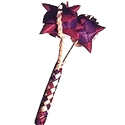The Thrissur Pooram is a daylong event held at the Vaddakunathan Temple in either the month of April or May that culminates in a procession of richly caparisoned elephants. Essentially, the festival is a contest between two groups representing the chief temples of the city, the Krishna Temple at Thiruvambadi and the Devi Temple at Paramekkavu, with the deity of the host temple acting as witness to the proceedings. Each faction comprises fifteen elephants, each decorated with anklets and a nettipattam, forehead ornament, and carrying three men. Of the three men perched atop the elephants the first holds the koda decorative parasols, the second the Venchamaram whisks of yak wool and the third the circular peacock feather fans aalavattam. The latter two perform in tandem with the rhythm of the chenda or the large drums, alternately holding their respective ritual objects aloft.
The central elephant amongst the fifteen from each temple carries the tidambu ceremonial shield and strapped to it is the idol of the temple it represents; the umbrella held is usually of a different colour than those flanking it and more ornate in order to assert the importance of the deity.
The temple faction with the most impressive display wins the contest; each temple therefore commissions their festival paraphernalia from a number of different craftsmen in utmost secrecy. The craftsmen are located in Kurmamkulam and Thrissur in Thrissur district.
The number and nature of the koda are determined by the temple authority and the generosity of patrons. Traditionally the koda were made of a variety of fabrics ornamented with tassels of dangling pendant like metal elements. The tidambu, a shield like object bearing the image of the deity is held by the priest seated on the chief elephant. The copper embellishments made by the thattan or goldsmiths are stitched onto fabric stretched on the main frame made by a carpenter.. At the foot of the tidambu is an arched form called the prabhamandala in which the idol of the temple deity is affixed for the duration of the procession.
Today the repertoire of motifs is far more daring with massive three dimensional sculptures of Theyyam masks, peacocks and images of deities in lightweight material or multi tiered koda fitted to the top of the umbrella. The traditional koda or umbrella embellished with lace, embroidery and metal tassels Nettipattam, a ceremonial forehead ornament worn by elephants. The nettipattam is constructed of embossed copper pieces that are stitched onto a blanket of the desired shape and size. The copper pieces stitched onto the nettipattam, follow a preordained limited design vocabulary; each form has a specific name and position – the snake hood is called the nagapaddam, the crescent is called the chandrakala, the centre piece is called the kumbakinam, the large roundels placed at the top of the nettipattam are called the cattakirmam and the row of roundels that follow it, decreasing in size as the nettipattam tapers towards the bottom, are known as the edakinnam. The edges of the nettipattam are decorated with woolen tassels in white, green, yellow, red, violet and occasionally also in rose and blue.
Gallery
YOUR VIEWS
PRACTITIONERS: INDIA
Access 70,000+ practitioners in 2500+ crafts across India.
BIBLIOGRAPHY
10,000+ listings on arts, crafts, design, heritage, culture etc.
GLOSSARY
Rich and often unfamiliar vocabulary of crafts and textiles.
SHOP at India InCH
Needs to be written.






